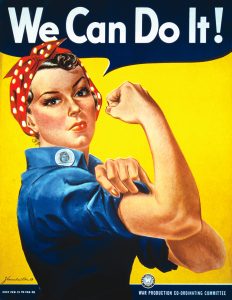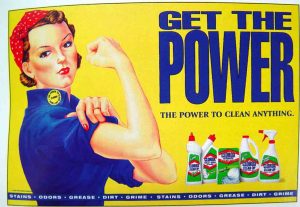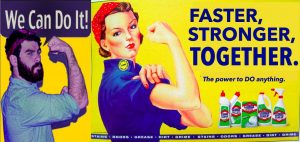Original WWII Propaganda
You have probably all seen this iconic Rosie the Riveter “We can do it” campaign poster before. J. Howard Miller originally produced this poster in the United States during World War II (1943) as propaganda to boost morale and increase female participation in the workforce. An article written by Lane Wallace in the Atlantic states, “the poster portrays women eager to take on jobs involving manual labor and/or heavy machinery” and the poster was “trying to convince the world that women could, in fact, do physical and traditionally male jobs” (2011). However, the poster actually grew in popularity and became famous after the war in the 1980’s as part of the feminist movement. It became a symbol for feminism in a period some may classify as the second wave of feminism, or as Linda Nicholson would prefer, a historic period for gender activism seen through the metaphor of a complex kaleidoscope, rather than a wave. “We” in “We can do it!” was seen as a push for all women. While the “we” could be seen as an oversight of the complexities of intersectional differences between the diverse women fighting for gender equality, the poster was seen as a positive symbol for the feminist movement. The poster embodied a stand for gender equality and a sense of empowerment for all women, regardless of their diverse backgrounds. It symbolized the ability for women to take on various roles, regardless of gender stereotyping or traditional roles for “men” and traditional roles for “women”.
Original Clorox Advertisement:
However, years later, Clorox came out with an advertisement for their cleaning products, using the same concept and almost identical branding as the traditional “We Can Do It!” campaign. A poster that was initially meant to encourage women to take on roles that were traditionally held by men, that then grew into a symbol for the feminist movement, which encouraged women to stand together, be independent and eliminate gender stereotyping and gender specific roles, had suddenly done a 180 degree turn. Clorox was using the same branding to advertise the complete opposite: women doing traditionally female roles: cooking, cleaning, and looking after the home. The advertisement, with an identical Rosie the Riveter states “Get the power, the power to clean anything,” taking away from the initial, progressive meaning of the poster, and replacing it with gender stereotypes and controversial, non-inclusive binary relationships. It placed the women directly back in the home, in a domestic role, rather than it’s initial purpose of getting women out of the home and into the workforce to take part in society, while most of the men were at war.
Jammed Version:
I changed the Clorox ad to feature a man and woman, while re-instating the traditional “We Can Do It!” slogan, with the intention of eliminating the traditional binary relationship, with gender specific roles and stereotypes. My intention with including the man was to eliminate gender stereotyping, create an advertisement that is more inclusive, opens peoples minds to eliminate bias and empower people to work together for a more equal, open minded society. I hoped that the inclusion of a man would remind people that cleaning and taking care of the house is not gender specific and should never make a man feel alienated and uncomfortable for doing a traditionally “woman’s job”, nor should it make a woman feel obligated and confined to take care of the house. I also changed “Get the power, the power to clean anything” to “Faster, stronger, together. The power to DO anything;” changing “power to clean” to “power to DO” was done with the intention to prove that Clorox is not only the most powerful cleaning product and allows you to clean anything, it also works so well and efficiently that it gives you the power to do more than just clean, to have more time to invest in the other work you desire to do. “The power to DO anything” is meant to re-empower women (and men) while eliminating gender roles and standards that have been established and preserved by mainstream society through media platforms. I also thought it was important to state “We can do it!” with a male and a female to move away from the traditional photograph to remind people that feminism is not just a women’s movement. Feminism is equality for all; therefore, the conversation should include everyone (men, women, trans, white, black etc.). Conversations and ideas ignites through mainstream media, let’s make that conversation an inclusive and positive one!
Nicholson, L. (2010). “Feminism in “waves”: Useful metaphor or not?” New Politics 12(4).
Wallace, Lane. “The Complex Legacy of Rosie the Riveter.” The Atlantic. Atlantic Media Company, 11 Jan. 2011. Web. 28 June 2017.


